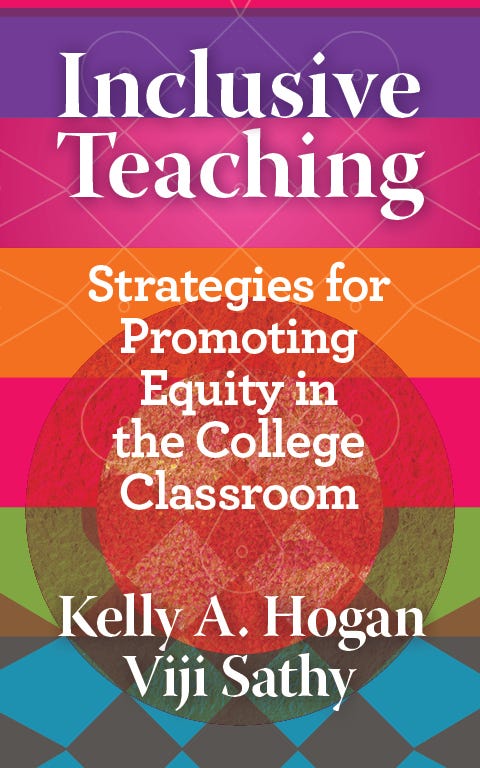Here’s a great read for Fall 2022:
Drs. Hogan and Sathy are STEM educators who have successfully leveraged inclusive teaching in their own classes and have led pedagogical transformation among colleagues. Chapters include the following:
Inclusive Teaching as a Mind-set
The Value of Structure
Designing your Course and Syllabus with an Inclusive Mind-set
Launching your Course
Classroom Environment and Interactions
Inclusive Practices Outside the Classroom
Reflecting and Documenting your Inclusive Practices
Each chapter ends with an instructor checklist. Suggestions are practical and manageable. Nearly everyone will walk away with something here, even those who have been doing this work for 157 years. I felt the alignment with Dr. Jim Lang’s Small Teaching (here’s another article that draws on his work in the context of inclusivity), which is a great approach: Small changes people can implement while continuing to interrogate their own ideas about teaching.
I was especially impressed that the authors noted the risks associated with some of their recommendations for women and for any racially minoritized faculty members. Positionality is not neutral.
The thesis at the heart of the work is that respect for students matters: Every inclusive practice is built around the idea of respecting students and their learning. Great! Five stars!
One thing I think about with regard to inclusive practice is that inclusive teaching asks many faculty to center respect in an environment where respect for them as educators and as professionals can be pretty low.
Some have laid out arguments around respect and related ideas: Adjunct faculty, shared governance, and managerialism. The impact of COVID-19 looms large, too, and the effect of organizational decision-making on faculty members’ perceptions of respect remains an unanswered empirical question at the moment.
I also think a lot about how respect can be an inoculating factor against burnout. I think about the “Toxic Five,” the characteristics of a toxic culture, and the relationship between disrespect and burnout1:

Here is some recent commentary on faculty burnout, specifically. Dr. Rebecca Pope also launched a recent episode of her podcast about burnout, too, sharing details from her forthcoming book, Unraveling Faculty Burnout.
In my own mind, the respect — burnout dynamics are wrapped this way:
A lack of respect in the organization contributes to burnout.
Asking faculty to engage in more inclusive teaching — which takes far more intellectual and emotional energy than more traditional methods — assumes that they’re operating in an environment conducive to that kind of work.
A healthy environment — one characterized by respect — is a means of protecting against burnout and supports the kind of experimentation inclusive teaching requires.
But I don’t know if most environments are conducive, really. I don’t think research supports the idea that faculty feel especially respected in their environments, in part because respect is subjective, as a construct:
What administrators think is respectful is likely different from what faculty think. What a person living the dynamics of one positionality thinks about respect is different from someone who experiences dynamics at a different intersection. So we’re often asking people who feel disrespected to amplify respect toward students and to engage in practices that can lead to burnout if the environment isn’t right.
While pointing out these dynamics is not likely politically advisable in an individual organization, doing so is certainly authentic and reflective of the lived experiences of many faculty. I can’t be a leader who advocates for inclusive practices — for care and compassion, for respect — while ignoring the condition of the larger waters in which that advocacy swims.
In Competing on Culture: Driving Change in Community Colleges, president of Mohawk Valley CC, Dr. Randall VanWagoner, points out that we’re all in one pond: An org that focuses only on the student experience is an org that won’t meet its goals. Attending to the dynamics of the entire ecosystem is mandatory if we have any hope of supporting pedagogical innovation.
Thus, my reading of anything that asks faculty to engage in care, compassion, and respectful practice is always colored by my view of larger organizational waters: How are faculty the beneficiaries of that same care, compassion, and respect? Do we model in the organization that which we hope to see in the classroom?
It’s a good contextually-situated empirical question, one that individual orgs can take on as part of their change readiness processes.
At the end of it, though, my point about this book stands: It’s helpful, clear, practical, and useful to educators. The writing is clean and engaging, the evidence effective, and the utility immediate.
For faculty operating in healthy, supportive environments where risk is low, I see no reason not to adopt these practices.
And just maybe — for those who aren’t already operating under the framework of inclusion — doing so will help people take on the larger organizational waters, as nothing highlights organizational contradictions and hypocrisy more than engaging in radically inclusive practice in the classroom.
Call for chapters! Global Movements toward Inclusive Settings in K-12 Classrooms and Higher Education. I want to submit a blistering chapter supporting my argument that the dynamics and conditions necessary for real inclusion are at odds with neoliberalism because the former elicits direct and indirect costs that the latter framework can’t bear and that it’s this friction at the heart of DEI struggles.
(I’d need to use the expression “situated for elegant failure,” though, and maybe that’s too saucy for this publication. Anyway, take a look!)
This piece is excellent in its summary of dynamics: Burnout is often conceptualized as an individual issue related to the demands of a job, but in actuality, org culture is of considerable influence.







